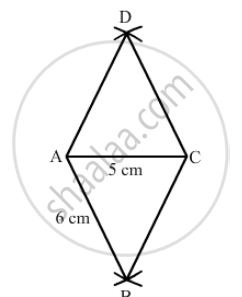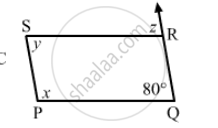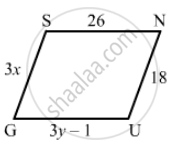Advertisements
Advertisements
प्रश्न
Draw a rhombus ABCD, if AB = 6 cm and AC = 5 cm.
उत्तर

1. Draw a line segment AC of 5 cm.
2. With A as centre, draw an arc of radius 6 cm on each side of AC.
3. With C as centre, draw an arc of radius 6 cm on each side of AC. These arcs intersect the arcs of step 2 at B and D.
4. Join AB, AD, CD and CB.
APPEARS IN
संबंधित प्रश्न
The following figure is parallelogram. Find the degree values of the unknown x, y, z.

In the following figure GUNS and RUNS are parallelogram. Find x and y.

If an angle of a parallelogram is two-third of its adjacent angle, find the angles of the parallelogram.
Which of the following statement is true for a rhombus?
Its diagonals bisect each other at right angles.
The diagonals of a quadrilateral are perpendicular to each other. Is such a quadrilateral always a rhombus? If your answer is 'No', draw a figure to justify your answer.
Construct a rhombus whose diagonals are of length 10 cm and 6 cm.
The given figure shows a rhombus ABCD in which angle BCD = 80°. Find angles x and y.

If a diagonal of a quadrilateral bisects both the angles, then it is a ______.
ABCD is a rhombus such that the perpendicular bisector of AB passes through D. Find the angles of the rhombus.
Hint: Join BD. Then ∆ABD is equilateral.
Construct a rhombus CLUE in which CL = 7.5 cm and LE = 6 cm.
